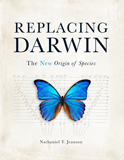
The Hidden Figure Behind Neo-Darwinism—Hugo de Vries
An examination of occult Marxist indoctrination in our schools
Through your precepts I get understanding; therefore I hate every false way. (Psalm 119:104)n
Evolution in textbooks and journals today is not the same type of evolution taught by Charles Darwin. In other words, if you read Darwin’s books, you can easily see that what he was preaching is not what is being utilized in current evolutionary publications. This is due to a major key factor that has changed the entire course of evolutionary thought.
Though Darwin keeps getting the credit, the man behind the modern view of evolution seems to be little more than a “footnote.” And his name is Hugo de Vries. But to understand the significance of his work, you need to understand what led up to his proposal and why it became arguably the most significant change in evolutionary thought since the days of Darwin.
Evolution Keeps Evolving
Epicureanism
The concept of evolution isn’t new. (Which may surprise you!) Contrary to popular belief, it wasn’t invented by Charles Darwin in the mid-to-late 1800s with his books Origin of Species1 (1859) and subsequently the Descent of Man2 (1871). Instead, it had roots that long preceded him to one of the ancient Greek mythologies by the Epicureans.3
Though this view had little popularity for over two millennia, it revived in the generations immediately before Darwin with men like Jean-Baptiste Lamarck4 and Erasmus Darwin (Charles Darwin’s grandfather).
Lamarckism
Erasmus Darwin wrote a two-volume book that included the Lamarckian style of evolution titled Zoonomia; or the Laws of Organic Life in 1794–1796. Although the book lacked significant development on evolutionary ideas and didn’t have a wide range of influence, it obviously still had influence on his grandson Charles Darwin.
Even so, Lamarck is the one credited for this form of evolution that now bears his name, “Lamarckism” (or “Lamarckianism”). He published an extensive evolutionary book in 1809 called Philosophie Zoologique, which means Zoological Philosophy in English, with the remaining title portion, or Exposition with Regard to the Natural History of Animals.
This early form of evolution by Lamarck was based on acquired characteristics that were presumed to be inheritable. In simple terms, if you cut off a sheep’s tail enough times, after so many generations, then the belief is the sheep in that generational line will stop growing them; or if a giraffe keeps stretching its neck longer and longer to reach high leaves on trees, then a longer neck will be generated in subsequent generations.
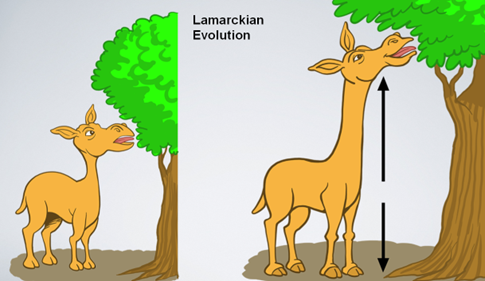
However, after observing these kinds of animals for multiple generations, the idea of acquired characteristics as the mechanism for evolution began dying a slow, painful death. In other words, the sheep kept growing tails, and the giraffe’s neck wasn’t affected in subsequent generations. The supposed acquired characteristics mechanism for evolution of new complex information had failed.

The failure of the Lamarckian mechanism then opened the door for Charles Darwin to enter the spotlight and propose a new mechanism for evolution.
Traditional Darwinism
The failure of the Lamarckian mechanism then opened the door for Charles Darwin to enter the spotlight and propose a new mechanism for evolution. (Though Darwin himself was still heavily influenced by Lamarck’s views, which were essentially the same as his grandfather’s.)
However, this mechanism wasn’t actually original to Charles. Rather, it was first developed by Edward Blyth (1810–1873)—a Christian trying to understand how animals change with minor characteristic variations between generations in various world regional climates. In other words, Blyth believed that animals have slight variations in different parts of the world, affected by nature, where some animals survive better than others in certain places.5
For instance, dogs with long hair survive better in cold regions, whereas dogs with short hair survive better in hot regions. Of course, this was prior to the days of Gregor Mendel’s (1822–1884) research. Mendel is considered the “father” of modern genetics. So, at this point in history, trying to understand how traits were inherited from one generation to another was still an interesting question.
Nevertheless, Darwin read and proposed Blyth’s work as the new mechanism to make evolution work. Darwin gave this observable process a name: “natural selection.” (Note, natural selection is just the name of a process—it is not personifying that nature has a mind by any means.6) But unlike Lamarck’s view, Blyth’s view was actually observed to occur.
As a result, Darwin became hugely popular. However, Darwin did not look at the process in the same way. Blyth saw natural selection as a conserving mechanism in God’s broken world, whereas Darwin tried to make natural selection into a creative mechanism. Darwin hoped natural selection would generate new and novel features that could gradually change one kind of creature into another kind if given enough time (“millions of years”).
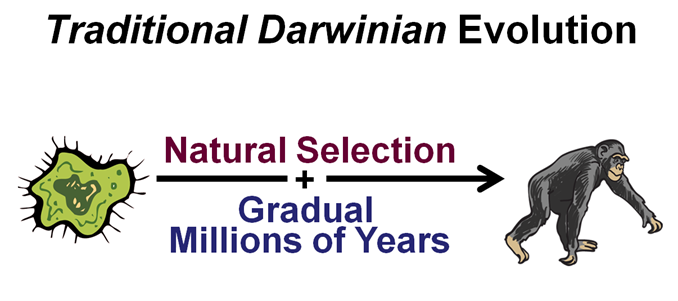
This view of natural selection is commonly called Traditional Darwinism, which immediately resonated with those who rejected biblical creation (God creating everything in six normal days in accordance with Scripture).
Consequently, this new evolutionary idea exploded onto the scene after being promoted by men like Alfred Russell Wallace (who rejected Lamarckism), Thomas Henry Huxley (Darwin’s “Bulldog”), and Ernst Haeckel (who was known for faked embryo data and popularized evolution to the German people). In fact, even devout Christians like Asa Gray were swayed to mix their Christianity with an evolutionary worldview (he was arguably the first popular theistic evolutionist).
Darwin’s view of natural selection was quickly accepted by academic society. As a result, this new evolutionary view made a dynamic shift in our cultural thought and way of life. By the 1870s, universities across the board were caving to these evolutionary ideas.7 In fact, even popular Christian colleges and universities (like Oxford, Harvard, and many others) began adopting these anti-biblical ideas—abandoning their Christian worldview—and raising the banner of a secular worldview.8
For 15–20 years, Darwin defended his ideas in letters and publications. His book Origin of Species went through six iterations with the final (sixth) edition, published in 1872, being his most famous and influential work. However, Darwin eventually realized there was something wrong with his view that natural selection was a creative process to generate new information. As documented by researcher Randall Hedtke, in Darwin’s first edition, he was adamant that natural selection was the mechanism that drove evolution.
But by that sixth edition, Darwin had backed off from being so adamant and instead was more tentative in that belief. Darwin even suggested that natural selection may not be the full mechanism responsible for evolution.9 That is, researchers acknowledged there were indeed changes due to natural selection (just like Blythe had said) but had realized those changes were going in the wrong direction (opposite of what evolution requires!).

Researchers found that changes due to natural selection filter and rearrange the already existing information in the offspring. This discovery meant natural selection was not the mechanism to generate new complex information but could only act on what was already there.
In the end, just like with Lamarck, Darwin and other evolutionists couldn’t see the changes they had hoped for. This conundrum now brings us to Hugo de Vries.
The Need for Another Mechanism
When Darwin breathed his last breath, he would stand before a holy God to face eternal judgment.10 But the torch he lit burned across the Western world (North America, Europe, and Australia). Hosts of people praised him and followed in his footsteps into the secular humanistic religion (a rehash of Greek Epicureanism).
All the while, only those “in the know” realized they still didn’t have a mechanism for evolution. This allowed Hugo de Vries to now enter the spotlight.
Neo-Darwinism
Hugo de Vries was a Dutch botanist and one of the first geneticists. Of course, the first was creationist Gregor Mendel, who spearheaded the genetics and heredity field (and others were copying and even plagiarizing his work—but that is for a different discussion!). Hugo de Vries was more focused on a modified version of Darwin’s view that included mutations (genetic changes via copying errors/mistakes in DNA).
Hugo wrote a book called Intracellular Pangenesis in 1889. In this book, he tried to modify Darwin’s understanding of pangenesis (where we later get the name “genes”). Hugo was best known for his particular view of mutation theory where he suggested that evolution proceeded due to mutations.11 He suggested mutations could result in abrupt evolutionary jumps or changes (called “saltation” or “saltationism”) more significant than typical Darwinist gradualism (slowly over long periods of time).
So, in the same way Darwin piggybacked off Blyth’s discovery of natural selection, Hugo de Vries had used Gregor Mendel’s discoveries of heredity to modify this to include mutations as the new mechanism for evolution.
Researchers quickly became fascinated with Hugo’s ideas, causing many of them to look at mutations in a new way. For instance, the famous ongoing fruit fly (drosophila melanogaster) experiment started by Thomas Morgan in 1907 (and later with Hermann Joseph Muller using X-rays to speed up mutation rates) was directly influenced by de Vries’ view of mutations. (By the way, fruit fly mutations are detrimental and thus not novel with new complexity even in our day, based on experimentation!)
In the following decades, many secularists rejected Hugo’s views on more rapid fluctuations (saltation) of onward and upward evolutionary changes. Most evolutionists want to slow it down over long ages.
Nonetheless, his proposal about mutations as the new mechanism to potentially make novel features for evolution still had a great ripple effect in the evolutionary community. From that day forward, mutations were seen as the key new mechanism for an evolutionary worldview within Darwin’s gradualism—shifting the entire paradigm of evolutionary thought.
Natural selection, however, was not thrown out and replaced—instead, evolutionists have kept both natural selection and mutations (along with long ages, of course) as a working pair known as neo-Darwinism (also called the modern evolutionary synthesis). In other words, this new “synthesis” combined Darwin’s view of natural selection with Mendelian genetics—but more precisely, Hugo de Vries’ view of mutations as being the new “driving force” for evolution.
Yet, today, Hugo de Vries is simply viewed as a “footnote” in evolutionary thought, with Mendel getting much of the credit. However, many don’t realize that Mendel was not an evolutionist!
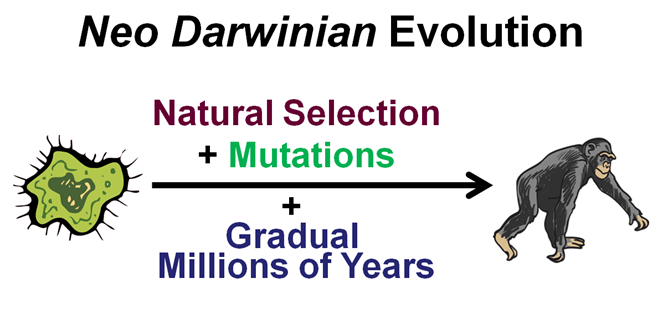
Yet, today, Hugo de Vries is simply viewed as a “footnote” in evolutionary thought, with Mendel getting much of the credit. However, many don’t realize that Mendel was not an evolutionist! In fact, he opposed evolution in favor of creation by God.12 So, although Mendel did spearhead the genetics and heredity research field and thus rightly deserves credit, I doubt he would have wanted his name associated with the modern evolutionary synthesis.
Punctuated Equilibrium
A revival of Hugo de Vries’ views is found in Niles Eldredge and Steven J. Gould’s punctuated equilibrium model13 (or even the hopeful monster model14). Essentially, this view reintroduces the saltation (as proposed by Hugo) in more detail, with more modern data, and attempts to explain why the fossil record doesn’t match Darwin’s gradualism.15

Nevertheless, punctuated equilibrium and hopeful monster models have not gained enough steam to put a dent into neo-Darwinism (the modern evolution synthesis) in the minds of evolutionists. Today, neo-Darwinism remains the primary religious perspective being imposed in textbooks, academia, and modern secular media.
For Those in the Know
But there is something else that needs to be addressed. Again, recall that changes due to natural selection are observed, but they were not going in the right direction for evolution. So do mutations lead to the evolutionary changes everyone hopes for? Do mutational changes go in the right direction? No—they do not.16
No doubt, mutations cause changes. (Everyone agrees on that point!) And granted, in some cases, there are some “nearly neutral” mutations, meaning the changes are not a noticeable gain/loss (still having the ability to make a protein even with tiny mistakes, for instance). But, for the most part, mutations have damaging effects on genes, with some bigger (more significant) mutations that can even cause serious detrimental changes, such as cancer or physical deformities. Obviously, these types of changes are the opposite of what’s required for an evolutionary worldview.17
Simply put, just like natural selection, mutational changes are going in the wrong direction. Mutations act on genes that already exist and destroy them—which means it is not the creative force to generate new complex information (capable of changing one creature into another). In other words, mutations do not generate any new information for novel, complex features and functions required for evolution to work (like nascent organs, for example—that is, the coming into existence of new organs and features).

So, contrary to popular belief, evolutionists still don’t actually have a mechanism for evolution to work! Those who are truly aware of the situation (and if they’re honest) will admit there is still a need for a proper mechanism for evolution. In the end, the onward and upward direction required for evolution to be possible are just not observed from either natural selection or mutations.
Yet evolutionists still cling to the hope that somewhere in the “millions of years” of supposed earth history there were mutations that led to onward and upward changes. But this idea is really nothing more than hopeful conjecture about the past, which is not observable, repeatable, or testable.
So, after knowing all this, you’re probably wondering why so many people still blindly believe in evolution? My suggestion is they aren’t the ones “in the know” on the subject. Thus, so many people blindly accept the claims that evolution *could* occur via natural selection and mutations without actually knowing these mechanisms fail to generate the new information required for evolution. Many times, people also blindly accept these evolutionary claims from scientists—simply because they’re considered the “experts” in the field of biology!
The Spiritual Battle Behind the Scenes
We know that we are from God, and the whole world lies in the power of the evil one. (1 John 5:19)
From a spiritual perspective, the evil one (Satan) and the father of lies (John 8:44) keeps people in the dark and has deceived multitudes in religions around the world. Why would we expect anything different with secular, man-made religions (which have now dominated our Western world) that have evolution as their primary capstone?
In fact, if you simply step back and look at the big picture, you’ll clearly see that modern secular evolution is just another intricately rebuilt, reformulated, and rehashed Greek mythology. Another way to put it, the modern evolutionary worldview is just reimagined pantheistic paganism, which is one form of pagan belief that the universe or cosmos is all that exists (i.e., naturalism).18
After 150 years, we see the devastating fruit of how this idea has destroyed Western civilization (which used to be considered honorable and respectable that others sought to be like, due to the influence of a biblical worldview). Western societies are now plagued with rampant abortion, drugs, sexual confusion, gender confusion, hate, and evolutionary racism.
From a biblical worldview, it makes sense that mechanisms like natural selection and mutations are filtering and losing information in our sin-cursed and broken world (due to sin; Genesis 3).
On the flip side, Blyth’s and Mendel’s views are still echoed by creation scientists today. We consistently observe variations within created kinds. From a biblical worldview, it makes sense that mechanisms like natural selection and mutations are filtering and losing information in our sin-cursed and broken world (due to sin; Genesis 3).
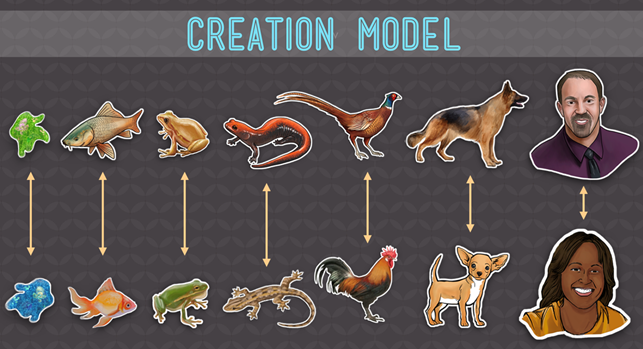
My hope is to see people seriously question the evolutionary religion (worldview) that they have been taught. This might include you? If you were anything like me, you have had this religion imposed on you in schools, from textbooks, media, and museums. And more than likely, you weren’t told that evolution is a religion being pushed on you. But don’t be afraid to question this man-made religion! When you look at the details, it is seriously problematic.
I also want to invite you to also reconsider the gospel claims of the Bible—starting in Genesis. On the subject of the past, the God of the Bible is the absolute authority who can be trusted from the very first verse unlike the changing ideas of man that keep turning out to be errant (Isaiah 2:22).
Artwork by Cameron Suter, Dan Lietha, and Bodie Hodge
Footnotes
- The full title is On the Origin of Species by Means of Natural Selection, or the Preservation of Favoured Races in the Struggle for Life
- The full title is The Descent of Man, and Selection in Relation to Sex
- Bodie Hodge, “If Paul Were Around Today, Would He Argue Against Evolutionists?” Apologetics, Answers in Genesis, June 14, 2010, https://answersingenesis.org/apologetics/if-paul-were-around-today-would-he-argue-against-evolutionists/.
- Technically, his name and title are Jean-Baptiste Pierre Antoine de Monet, chevalier de Lamarck
- Edward Blyth, “An Attempt to Classify the ‘Varieties’ of Animals, with Observations on the Marked Seasonal and Other Changes Which Naturally Take Place in Various British Species, and Which Do Not Constitute Varieties,” Magazine of Natural History 8, no. 1 (1835): 40–53, http://people.wku.edu/charles.smith/biogeog/BLYT1835.htm; and Edward Blyth, “A Suggested New Division of the Earth Into Zoological Regions,” Nature 3 (1871): 427–429, http://people.wku.edu/charles.smith/biogeog/BLYT1871.htm.
- Like the tree of life or the tree of knowledge of good and evil—they are names of trees. This doesn’t mean that knowledge come from a personified tree for instance.
- Jon Roberts and James Turner, The Sacred and the Secular University (Princeton, NJ: Princeton University Press, 2000).
- Bodie Hodge, “Harvard, Yale, Princeton, Oxford—Once Christian?” Answers Magazine, June 27, 2007, https://answersingenesis.org/christianity/harvard-yale-princeton-oxford-once-christian/.
- Randall Hedtke, Secrets of the Sixth Edition: Darwin Discredits His Own Theory (Green Forest, AR: Master Books, 2010).
- Tommy Mitchell, “Darwin’s Deathbed Conversion—a Legend?” Creation, Answers in Genesis, March 31, 2009, https://answersingenesis.org/creationism/arguments-to-avoid/darwins-deathbed-conversion-a-legend/.
- Hugo de Vries, while studying the wild plant: Oenothera Lamarckiana, in 1886; later he published his research on mutations in Die Mutationstheorie (1901–03; The Mutation Theory).
- Harry F. Sanders, III, “Gregor Mendel: No Darwinian,” Answers in Depth 15, July 22, 2020, https://answersingenesis.org/creation-scientists/gregor-mendel-no-darwinian/.
- Niles Eldredge and S. J. Gould, “Punctuated Equilibria: An Alternative to Phyletic Gradualism,” in Thomas .J. M. Schopf, (ed.), Models in Paleobiology (San Francisco: Freeman Cooper, 1972), 82–115
- David Menton, “The Hopeful Monsters of Evolution,” in Essays on Origins: Creation vs. Evolution, St. Louis MetroVoice 4, no. 6 (June 1994), reprinted September 2, 2017, https://answersingenesis.org/fossils/fossil-record/hopeful-monsters-of-evolution/.
- Terry Mortenson, “Was Darwin Right?” Evolution, Answers in Genesis, March 24, 2014, https://answersingenesis.org/charles-darwin/darwinism/was-darwin-right/.
- Bodie Hodge, “Are Mutations Part of the ‘Engine’ of Evolution?” in The New Answers Book 2 (Green Forest, AR: Master Books, 2008), https://answersingenesis.org/genetics/mutations/are-mutations-part-of-the-engine-of-evolution/.
- John C. Sanford, Genetic Entropy & the Mystery of the Genome (Waterloo, NY: FMS Publications, 2005).
- Bodie Hodge and Roger Patterson, World Religions and Cults Volume 3 (Green Forest, AR: Master Books, 2016), 11–28, 63–84, 147–163, and 205–226.
Recommended Resources

Answers in Genesis is an apologetics ministry, dedicated to helping Christians defend their faith and proclaim the good news of Jesus Christ.
- Customer Service 800.778.3390
- © 2024 Answers in Genesis





